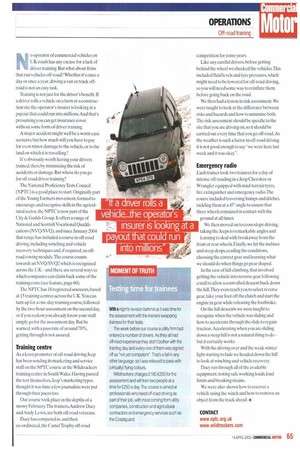WHEN THE GOING GETS ROUGH...
Page 66

Page 67

If you've noticed an error in this article please click here to report it so we can fix it.
No one in their right mind would drive a CV on the road without adequate training and drivers heading off-road also need to be shown the ropes. We sent Dan Gilkes to get his hands dirty.
No operator of commercial vehicles on UK roads has any excuse for a lack of driver training. But what about firms that run vehicles off-road? Whether its once a day or once a year, driving a van or truck offroad is not an easy task.
Training is not just for the driver's benefit. If a driver rolls a vehicle on a farm or a construction site the operator's insurer is looking at a payout that could run into millions.And that's presuming you can get insurance cover without some form of driver training.
A major accident might well be a worst-case scenario, hut how much will you have to pay for even minor damage to the vehicle, or to the land on which it is travelling?
It's obviously worth having your drivers trained, thereby minimising the risk of accidents or damage. But where do you go for off-road driver training?
The National ProficiencyTests Council (NPTC) is a good place to start. Originally part of the Young Farmers movement,formed to encourage and recognise skills in the agricultural sector, the NPTC is now part of the City & Guilds Group. It offers a range of National and ScottishVocational Qualifications (NVQ/SVQ), and since January 2004 that range has included a course in off-road driving, including winching and vehicle recovery techniques and, if required, an offroad towing module.The course counts towards an NVQ/SVQ2 which is recognised across the UK — and there are several ways in which companies can claim back some of the training costs (see feature, page 60).
The NPTC has 18 registered assessors, based at 15 training centres across the UK.You can turn up for a one-day training course, followed by the two-hour assessment on the second day, or if you reckon you already know your stuff simply go for the assessment day. But be warned, with a pass rate of around 70%, getting through is not assured.
Training centre
As a keen promoter of off-road driving Jeep has been sending its marketing and service staff on the NPTC course at the Wildtrack ers training centre in South Wales. Having passed the test themselves, Jeep's marketing types thought it was time a few journalists were put through their paces too.
Our course took place in the depths of a snowy February.The trainers,Andrew Dacy and Andy Lewis, are both off-road veterans.
Dacy has competed in, and then co-ordinated, the Camel Trophy off-road competition for some years Like any careful drivers, before getting behind the wheel we checked the vehicles. This included fluid levels and tyre pressures, which might need Lobe lowered for off-road driving, so you will need some way to reinflate them before going back on the road.
We then had a lesson in risk assessment. We were taught to look at the difference between risks and hazards and how to minimise both. The risk assessment should be specific to the site that you are driving on, so it should be carried out every time that you go off-road.As the weather is such a factor in off-road driving it is not good enough to say "we were here last week and it was okay".
Emergency radio
Each trainer took two trainees for a day of intense off-roading in a Jeep Cherokee or Wrangler equipped with mud-terrain tyres, fire extinguisher and emergency radio.The course included traversing humps and ditches, tackling them at a 45° angle to ensure that three wheels remained in contact with the ground at all times.
We then moved on to cross-slope driving, taking the Jeeps to remarkable angles and learning to deal with breakaway from the front or rear wheels. Finally, we hit the inclines and steep drops, reading the conditions, choosing the correct gear and learning what we should do when things go pear shaped.
In the case of hill-climbing, that involved getting the vehicle into reverse gear following a stall to allow a controlled descent back down the hill.They even teach you to select reverse gear, take your foot off the clutch and start the engine in gear while releasing the footbrake.
On the hill descents we were taught to recognise when the vehicle was sliding and how to accelerate through the slide to regain traction. Accelerating when you are sliding down a steep hill is not a natural thing to do — but it certainly works.
With the driving over and the weak winter light starting to fade we headed down the hill to look at winching and vehicle recovery.
Dacy ran through all of the available equipment, noting safe working loads, load limits and breaking strains.
We were also shown how to recover a vehicle using the winch and how to remove an object from the track ahead.










































































































































































































